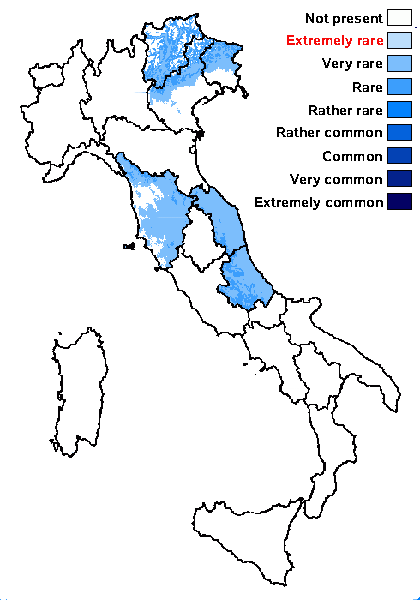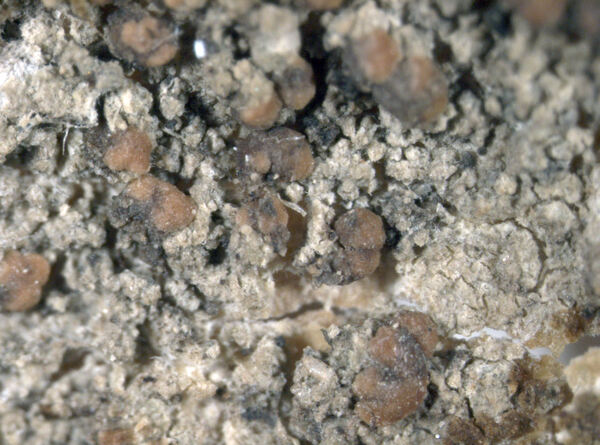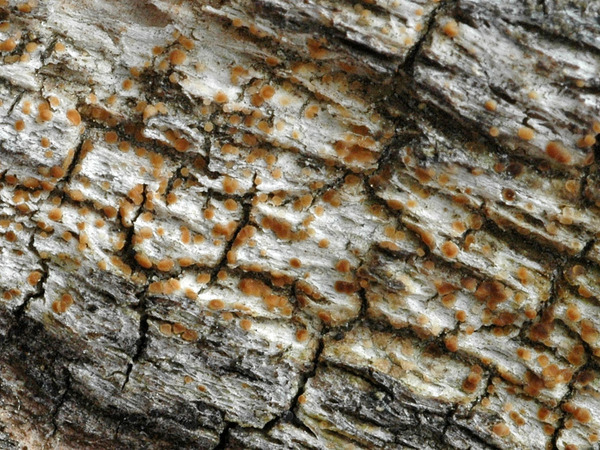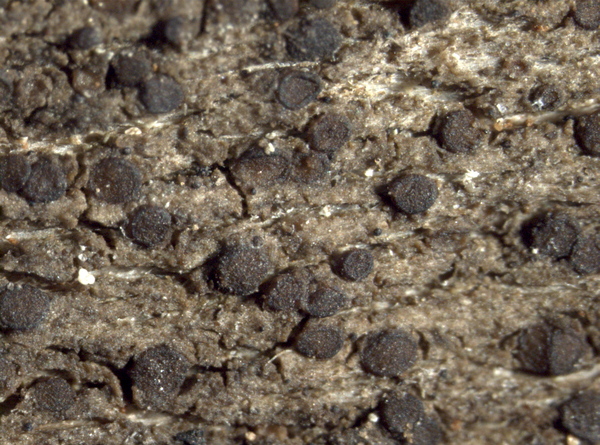Catillaria erysiboides (Nyl.) Th. Fr.
Lichenogr. Scand., 2: 572, 1874. Basionym: Lecidea erysiboides Nyl. - Not. Sällsk. Fauna Fl. Fenn., 4: 232, 1859.
Synonyms: Biatorina erysiboides (Nyl.) Arnold
Distribution: N - Frl, Ven (Nascimbene & al. 2005b), TAA (Nimis & al. 2015, Nascimbene & al. 2022), Lig (Giordani & al. 2025). C - Tosc, Marc, Abr (Nimis & Tretiach 1999).
Description: Thallus crustose, greenish or grey-green, minutely granulose, very thin and often indistinct. Apothecia lecideine, 0.2-0.4 mm across, round to sometimes confluent and irregular in outline, yellowish-brown, red-brown to finally sometimes brown-black, with a concave to finally strongly convex disc and an initially raised, but soon excluded proper margin. Proper exciple pale yellow to dark brown in outer part, more or less colourless in inner part, 40-60(-70) μm thick at base, K-; epithecium pale brown; hymenium colourless, (35-)40-60 μm high, I+ blue; paraphyses not coherent, more or less branched in upper part; hypothecium pale yellow, K-. Asci 8-spored, clavate, with an amyloid, slightly broadening tube-structure, approaching the Psora-type. Ascospores 1-septate, with unequal cells, hyaline, ellipsoid (6-)8-13(-15) x (3-)4-5(-6) μm. Photobiont chlorococcoid. Spot tests: thallus and apothecia K-, C-, KC-, P-, UV-. Chemistry: without lichen substances. Note: on hard lignum, e.g. on horizontal faces of old stumps. According to Coppins (1981) the epithet erysiboides was used for widely different taxa (e.g. Mycobilimbia carneoalbida, Lecania cyrtella and related taxa, Micarea prasina, etc.); records from Tuscany and Marche (Nimis 1993: 204) need confirmation: they could refer to Micarea prasina or related species. The species does not belong to Catillaria s.str.
Growth form: Crustose
Substrata: lignum
Photobiont: green algae other than Trentepohlia
Reproductive strategy: mainly sexual
Commonnes-rarity: (info)
Alpine belt: absent
Subalpine belt: very rare
Oromediterranean belt: rare
Montane belt: rare
Submediterranean belt: very rare
Padanian area: absent
Humid submediterranean belt: very rare
Humid mediterranean belt: absent
Dry mediterranean belt: absent

Predictive model
Herbarium samples
Growth form: Crustose
Substrata: lignum
Photobiont: green algae other than Trentepohlia
Reproductive strategy: mainly sexual
Commonnes-rarity: (info)
Alpine belt: absent
Subalpine belt: very rare
Oromediterranean belt: rare
Montane belt: rare
Submediterranean belt: very rare
Padanian area: absent
Humid submediterranean belt: very rare
Humid mediterranean belt: absent
Dry mediterranean belt: absent

Predictive model
| Herbarium samples |
 INDEX FUNGORUM
INDEX FUNGORUM
 GBIF
GBIF
 DOLICHENS
DOLICHENS





